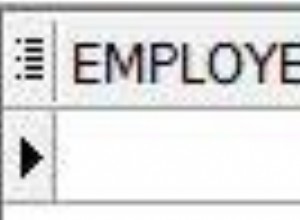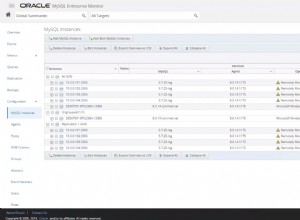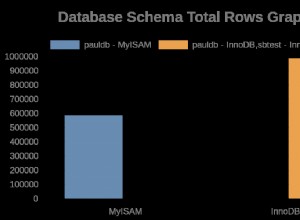Modifiqué mi respuesta dada en la primera pregunta...
Sería mejor si su tabla mantuviera los datos de relación directamente en columnas indexadas. Antes de cambiar la estructura de su tabla, puede probar esto:
Una tabla con datos de prueba
DECLARE @tbl TABLE ( AccountID VARCHAR(100), AccountName VARCHAR(100));
INSERT INTO @tbl VALUES
('11','Acc11')
,('12','Acc12')
,('13','Acc13')
,('11/11','Acc11/11')
,('11/12','Acc11/12')
,('11/111','Acc11/111')
,('11/11/001','Acc11/11/001')
,('11/11/002','Acc11/11/002')
,('12/111','Acc12/111')
,('12/112','Acc12/112');
Esto obtendrá los datos necesarios en una tabla temporal recién creada llamada #tempHierarchy
SELECT AccountID
,AccountName
,ROW_NUMBER() OVER(ORDER BY LEN(AccountID)-LEN(REPLACE(AccountID,'/','')),AccountID) AS ID
,Extended.HierarchyLevel
,STUFF(
(
SELECT '/' + A.B.value('.','varchar(10)')
FROM Extended.IDsXML.nodes('/x[position() <= sql:column("HierarchyLevel")]') AS A(B)
FOR XML PATH('')
),1,2,'') AS ParentPath
,Extended.IDsXML.value('/x[sql:column("HierarchyLevel")+1][1]','varchar(10)') AS ownID
,Extended.IDsXML.value('/x[sql:column("HierarchyLevel")][1]','varchar(10)') AS ancestorID
INTO #tempHierarchy
FROM @tbl
CROSS APPLY(SELECT LEN(AccountID)-LEN(REPLACE(AccountID,'/','')) + 1 AS HierarchyLevel
,CAST('<x></x><x>' + REPLACE(AccountID,'/','</x><x>') + '</x>' AS XML) AS IDsXML) AS Extended
;
El resultado intermedio
+-----------+--------------+----+----------------+------------+-------+------------+
| AccountID | AccountName | ID | HierarchyLevel | ParentPath | ownID | ancestorID |
+-----------+--------------+----+----------------+------------+-------+------------+
| 11 | Acc11 | 1 | 1 | | 11 | |
+-----------+--------------+----+----------------+------------+-------+------------+
| 12 | Acc12 | 2 | 1 | | 12 | |
+-----------+--------------+----+----------------+------------+-------+------------+
| 13 | Acc13 | 3 | 1 | | 13 | |
+-----------+--------------+----+----------------+------------+-------+------------+
| 11/11 | Acc11/11 | 4 | 2 | 11 | 11 | 11 |
+-----------+--------------+----+----------------+------------+-------+------------+
| 11/111 | Acc11/111 | 5 | 2 | 11 | 111 | 11 |
+-----------+--------------+----+----------------+------------+-------+------------+
| 11/12 | Acc11/12 | 6 | 2 | 11 | 12 | 11 |
+-----------+--------------+----+----------------+------------+-------+------------+
| 12/111 | Acc12/111 | 7 | 2 | 12 | 111 | 12 |
+-----------+--------------+----+----------------+------------+-------+------------+
| 12/112 | Acc12/112 | 8 | 2 | 12 | 112 | 12 |
+-----------+--------------+----+----------------+------------+-------+------------+
| 11/11/001 | Acc11/11/001 | 9 | 3 | 11/11 | 001 | 11 |
+-----------+--------------+----+----------------+------------+-------+------------+
| 11/11/002 | Acc11/11/002 | 10 | 3 | 11/11 | 002 | 11 |
+-----------+--------------+----+----------------+------------+-------+------------+
Y ahora tiene lugar un enfoque recursivo similar al de mi primera respuesta. Pero, como ahora está usando una tabla real y ya se ha realizado toda la división de cadenas, debería ser más rápido...
WITH RecursiveCTE AS
(
SELECT th.*
,CAST(NULL AS BIGINT) AS ParentID
,CASE WHEN EXISTS(SELECT 1 FROM #tempHierarchy AS x WHERE x.ParentPath=th.AccountID) THEN 1 ELSE 0 END AS HasChild
FROM #tempHierarchy AS th WHERE th.HierarchyLevel=1
UNION ALL
SELECT sa.AccountID
,sa.AccountName
,sa.ID
,sa.HierarchyLevel
,sa.ParentPath
,sa.ownID
,sa.ancestorID
,(SELECT x.ID FROM #tempHierarchy AS x WHERE x.AccountID=sa.ParentPath)
,CASE WHEN EXISTS(SELECT 1 FROM #tempHierarchy AS x WHERE x.ParentPath=sa.AccountID) THEN 1 ELSE 0 END AS HasChild
FROM RecursiveCTE AS r
INNER JOIN #tempHierarchy AS sa ON sa.HierarchyLevel=r.HierarchyLevel+1
AND r.AccountID=sa.ParentPath
)
SELECT r.AccountID
,r.AccountName
,r.ID
,r.ParentID
,r.HierarchyLevel
,r.HasChild
FROM RecursiveCTE AS r
ORDER BY HierarchyLevel,ParentID;
Y finalmente limpio
DROP TABLE #tempHierarchy;
Y aquí está el resultado final
+-----------+--------------+----+----------+----------------+----------+
| AccountID | AccountName | ID | ParentID | HierarchyLevel | HasChild |
+-----------+--------------+----+----------+----------------+----------+
| 11 | Acc11 | 1 | NULL | 1 | 1 |
+-----------+--------------+----+----------+----------------+----------+
| 12 | Acc12 | 2 | NULL | 1 | 1 |
+-----------+--------------+----+----------+----------------+----------+
| 13 | Acc13 | 3 | NULL | 1 | 0 |
+-----------+--------------+----+----------+----------------+----------+
| 11/11 | Acc11/11 | 4 | 1 | 2 | 1 |
+-----------+--------------+----+----------+----------------+----------+
| 11/111 | Acc11/111 | 5 | 1 | 2 | 0 |
+-----------+--------------+----+----------+----------------+----------+
| 11/12 | Acc11/12 | 6 | 1 | 2 | 0 |
+-----------+--------------+----+----------+----------------+----------+
| 12/111 | Acc12/111 | 7 | 2 | 2 | 0 |
+-----------+--------------+----+----------+----------------+----------+
| 12/112 | Acc12/112 | 8 | 2 | 2 | 0 |
+-----------+--------------+----+----------+----------------+----------+
| 11/11/001 | Acc11/11/001 | 9 | 4 | 3 | 0 |
+-----------+--------------+----+----------+----------------+----------+
| 11/11/002 | Acc11/11/002 | 10 | 4 | 3 | 0 |
+-----------+--------------+----+----------+----------------+----------+




